Pierre-Yves Saumont - The Joy of Kotlin
Here you can read online Pierre-Yves Saumont - The Joy of Kotlin full text of the book (entire story) in english for free. Download pdf and epub, get meaning, cover and reviews about this ebook. year: 0, publisher: Manning, genre: Computer. Description of the work, (preface) as well as reviews are available. Best literature library LitArk.com created for fans of good reading and offers a wide selection of genres:
Romance novel
Science fiction
Adventure
Detective
Science
History
Home and family
Prose
Art
Politics
Computer
Non-fiction
Religion
Business
Children
Humor
Choose a favorite category and find really read worthwhile books. Enjoy immersion in the world of imagination, feel the emotions of the characters or learn something new for yourself, make an fascinating discovery.
- Book:The Joy of Kotlin
- Author:
- Publisher:Manning
- Genre:
- Year:0
- Rating:3 / 5
- Favourites:Add to favourites
- Your mark:
- 60
- 1
- 2
- 3
- 4
- 5
The Joy of Kotlin: summary, description and annotation
We offer to read an annotation, description, summary or preface (depends on what the author of the book "The Joy of Kotlin" wrote himself). If you haven't found the necessary information about the book — write in the comments, we will try to find it.
The Joy of Kotlin — read online for free the complete book (whole text) full work
Below is the text of the book, divided by pages. System saving the place of the last page read, allows you to conveniently read the book "The Joy of Kotlin" online for free, without having to search again every time where you left off. Put a bookmark, and you can go to the page where you finished reading at any time.
Font size:
Interval:
Bookmark:

The figure on the cover of The Joy of Kotlin is captioned Habit of a Lady in Chinese Tartary, 1700. The illustration is taken from Thomas Jefferys A Collection of the Dresses of DifferentNations, Ancient and Modern (four volumes), London, published between 1757 and 1772. The title page states that these are hand-colored copperplate engravings, heightened with gum arabic.
Thomas Jefferys (17191771) was called Geographer to King George III. He was an English cartographer who was the leading map supplier of his day. He engraved and printed maps for government and other official bodies and produced a wide range of commercial maps and atlases, especially of North America. His work as a mapmaker sparked an interest in local dress customs of the lands he surveyed and mapped, which are brilliantly displayed in this collection. Fascination with faraway lands and travel for pleasure were relatively new phenomena in the late 18th century, and collections such as this one were popular, introducing both the tourist as well as the armchair traveler to the inhabitants of other countries.
The diversity of the drawings in Jefferys volumes speaks vividly of the uniqueness and individuality of the worlds nations some 200 years ago. Dress codes have changed since then, and the diversity by region and country, so rich at the time, has faded away. Its now often hard to tell the inhabitants of one continent from another. Perhaps, trying to view it optimistically, weve traded a cultural and visual diversity for a more varied personal lifeor a more varied and interesting intellectual and technical life.
At a time when its difficult to tell one computer book from another, Manning celebrates the inventiveness and initiative of the computer business with book covers based on the rich diversity of regional life of two centuries ago, brought back to life by Jeffreys pictures.
Pierre-Yves Saumont

Manning
Shelter Island
For online information and ordering of this and other Manning books, please visit www.manning.com. The publisher offers discounts on this book when ordered in quantity.
For more information, please contact
Special Sales Department
Manning Publications Co.
20 Baldwin Road
PO Box 761
Shelter Island, NY 11964
Email:
2018 by Manning Publications Co. All rights reserved.
No part of this publication may be reproduced, stored in a retrieval system, or transmitted, in any form or by means electronic, mechanical, photocopying, or otherwise, without prior written permission of the publisher.
Many of the designations used by manufacturers and sellers to distinguish their products are claimed as trademarks. Where those designations appear in the book, and Manning Publications was aware of a trademark claim, the designations have been printed in initial caps or all caps.
Recognizing the importance of preserving what has been written, it is Mannings policy to have the books we publish printed on acid-free paper, and we exert our best efforts to that end. Recognizing also our responsibility to conserve the resources of our planet, Manning books are printed on paper that is at least 15 percent recycled and processed without the use of elemental chlorine.
Manning Publications Co.
20 Baldwin Road
PO Box 761
Shelter Island, NY 11964
Development editor: Marina Michaels and Kristen Waterson
Technical development editor: Riccardo Terrell, Joshua White, and Joel Kotarski
Review editor: Aleks Dragosavljevic
Production editor: Deirdre Hiam
Copy editor: Frances Buran
Proofreader: Keri Hales
Technical proofreader: Alessandro Campeis
Typesetter: Happenstance Type-O-Rama
Cover designer: Marija Tudor
ISBN 9781617295362
Printed in the United States of America
1 2 3 4 5 6 7 8 9 10 SP 24 23 22 21 20 19
Although Kotlin appeared in 2011, its one of the newest languages in the Java ecosystem. Since then, a version of Kotlin running on the JavaScript virtual machine as been released, as well as a version compiling to native code. This makes Kotlin a much more universal language than Java, although there are great differences between these versions because the Java version relies upon the Java standard library, which isnt available in the two others. JetBrains, the creator or Kotlin, is working hard to bring each version to an equivalent level, but this will take some time.
The JVM (Java Virtual Machine) version is by far the most used version, and this has seen a great boost when Google decided to adopt Kotlin as an official language for developing Android applications. One of the primary reasons for Googles adoption was that the version of Java available under Android is Java 6, whereas Kotlin offers most of the features of Java 11 and much more. Kotlin was also adopted by Gradle as the official language for writing build scripts to replace Groovy, which allows using the same language for the build and for what is built.
Kotlin is primarily targeted at Java programmers. There might come a time when programmers will learn Kotlin as their primary language. But for now, most programmers will only be transitioning from Java to Kotlin.
Each language has its own way, determined by some fundamental concepts. Java was created with several strong concepts in mind. Its supposed to run everywhere, meaning in any environment for which a JVM is available. The promise was, Write once, run anywhere. Although some may argue otherwise, this promise was fulfilled. Not only can you run Java programs nearly everywhere, but you can also run programs written in other languages and compiled for the JVM. Kotlin is one of those languages.
Another of Javas promises was that no evolution would ever break existing code. Although this hasnt always been true, it has most often been respected. But this might not be a good thing. The main consequence is that many improvements in other languages couldnt be brought into Java because those improvements would have destroyed compatibility. Any program compiled with a previous version of Java must be able to run in the newer versions without being recompiled. Whether this is useful or not is a matter of opinion, but the result is that backward compatibility has constantly played against Javas evolution.
Java was also supposed to make programs safer by using checked exceptions, thus forcing programmers to take these exceptions into consideration. For many programmers, this has proven to be a burden, leading to the practice of constantly wrapping checked exceptions into unchecked ones.
Although Java is an object-oriented language, its supposed to be as fast as most languages for crunching numbers. The language designers decided that besides objects representing numbers and Boolean values, Java would benefit from having corresponding non-object primitives, allowing for much faster computations. The consequence was that you couldnt (and still cant) put primitives into collections such as lists, sets, or maps. And when streams were added, the language designers decided to create specific versions for primitivesbut not all primitives, only those most commonly used. If youre using some of the unsupported primitives, youre out of luck.
The same thing happened with functions. Generic functions were added to Java 8, but they only allowed manipulating objects, not primitives. So specialized functions were designed to handle integers, longs, doubles, and Booleans. (Again, unfortunately, not all primitives. There are no functions for byte, short, and float primitive types.) To make things even worse, additional functions were needed to convert from one primitive type to another or from primitives to objects and back.
Font size:
Interval:
Bookmark:
Similar books «The Joy of Kotlin»
Look at similar books to The Joy of Kotlin. We have selected literature similar in name and meaning in the hope of providing readers with more options to find new, interesting, not yet read works.
Discussion, reviews of the book The Joy of Kotlin and just readers' own opinions. Leave your comments, write what you think about the work, its meaning or the main characters. Specify what exactly you liked and what you didn't like, and why you think so.

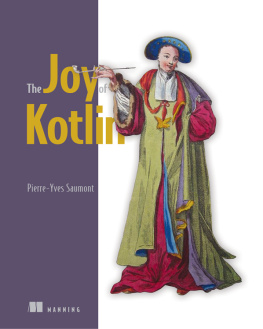


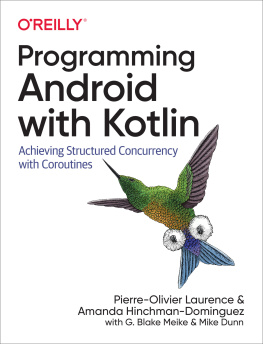
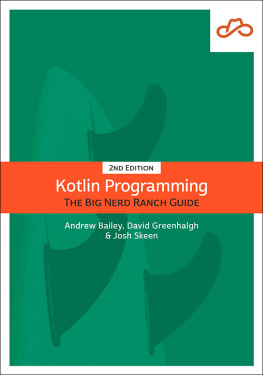

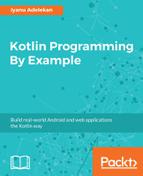
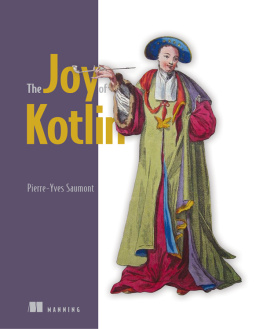

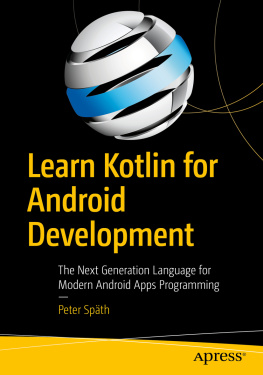

![Pierre-Yves Saumont [Pierre-Yves Saumont] - Functional Programming in Java: How functional techniques improve your Java programs](/uploads/posts/book/119337/thumbs/pierre-yves-saumont-pierre-yves-saumont.jpg)